Science fair project displays can seem like a daunting task for many students. However, there are some simple tips and tricks to make it easier for yourself!
This article will help you with your display by giving you free layouts and examples to use.
We provide a variety of science fair board ideas designed for different purposes, such as displaying all your entries or just some of them.
There is also information about how to organize your project, what materials you will need and more..
Steps to Plan Your Science Fair Display Board
We have learned the following advice from working with thousands of middle school students over the years.
By reading this post and following the tutorial, you will be on your way to a great display that will impress judges, parents, and spectators.
Your display board will be the only part of your science fair project that your child and anyone visiting the school will see. It’s your opportunity to show the judges that your child deserves recognition for their project and all the hard work they’ve put in.
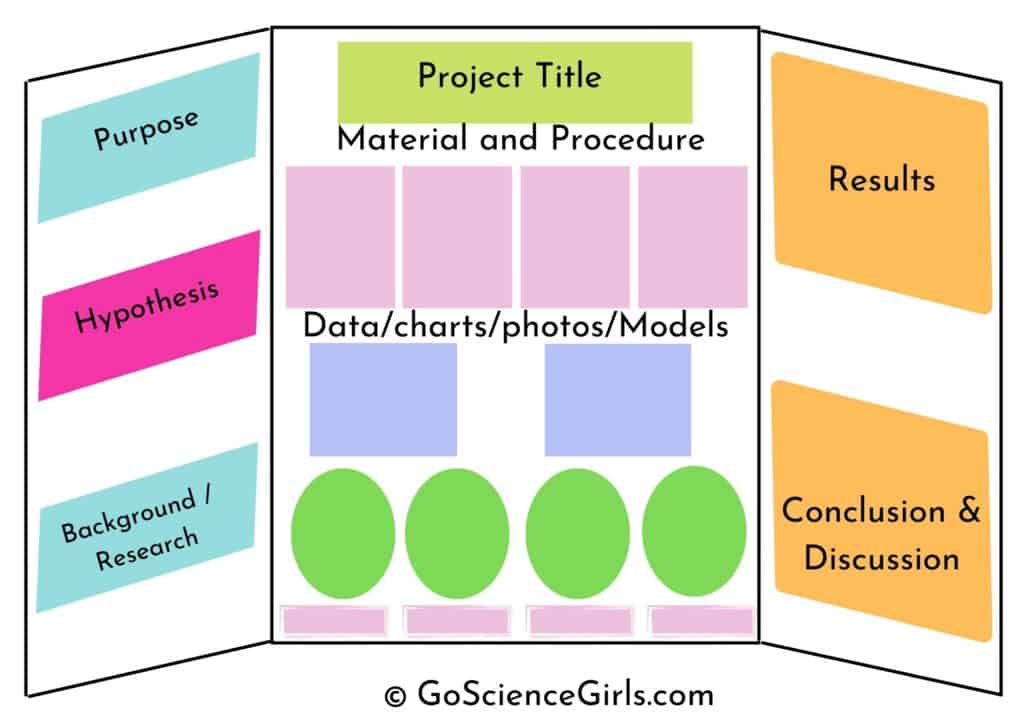
So, how do you put together a plan for it?
Many project display boards follow a schematic format and are typically outlined in black marker, usually in columns. The columns represent the different pieces of information that the board contains.
Create a detailed plan of your project and board.
If you’re unsure where to start or how to go about it, consider the complete science fair project steps below.
1. Plan
2. Organize
3. Research
4. Design
5. Build
6. Test
7. Display
8. Evaluate
9. Repeat
Know Rules / Regulations of Science Fair Competition
When it comes to the judging of science fair projects, it’s important to know the rules. Most competitions will have a list of criteria for judging, and following these can help your project stand out.
If you’re following a science fair project book, check its list of judging criteria. Many science fair books have a list of categories and points for each, so you can run a quick Google search to see if your book matches up with the criteria of the competition you’re entering.
If you’re entering a local science fair, ask someone there about the criteria for judging. Many local science fairs have online entry forms where you can also find out about criteria.
If your competition is online, go to the competition website and search for the rules or criteria. Many science fair websites have downloadable copies of their rules, so you won’t have to hunt them down.
You might also ask the science fair coordinator or teacher for a copy of the rules. Many science fairs take entries online, so organizers have access to this information.
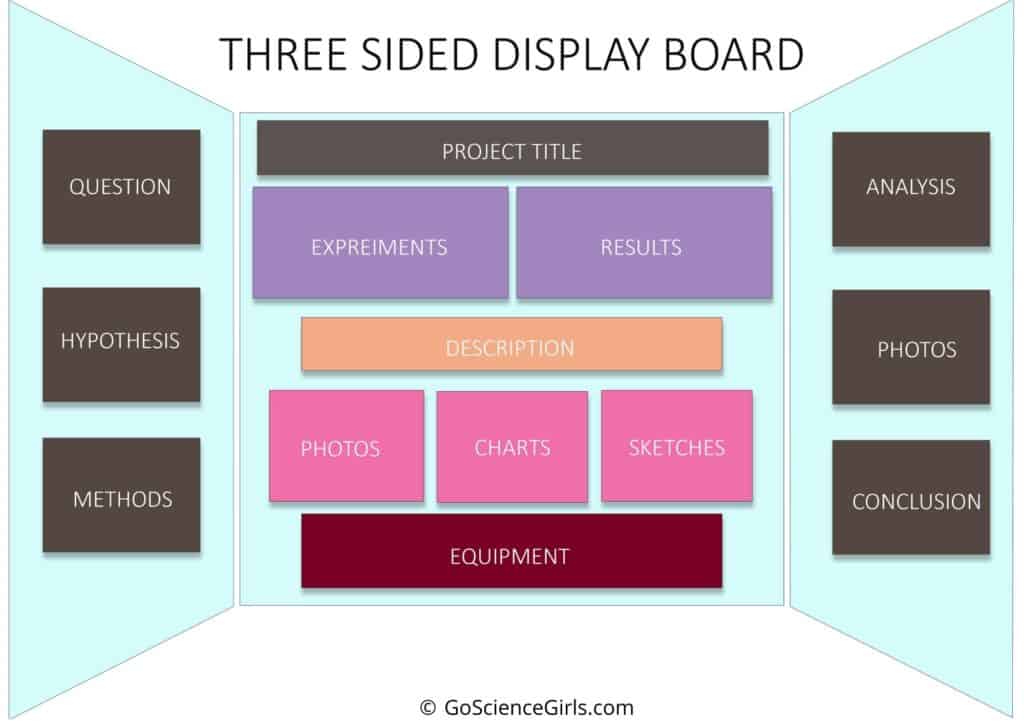
If you’re entering a national science fair, check its website for rules. Science fair rules vary widely from competition to competition, so you may have to do a little more research, but it’s usually not hard to find.
Once you’ve found the rules, make sure to follow them. Certain rules may vary from school to school, so it’s best to do a small web search first.
Some science fair rules might be hidden; be sure to look in the “Additional Information” section or check the website’s FAQ page. If you’re still unsure whether the rules apply to your project, ask the teacher or coordinator.
Sections to cover in Display Board

The science fair project display board is the students’ opportunity to showcase their hard work and how they solved a problem or question.
Good science fair project display boards should be organized, easy to read, and visually appealing. The science fair judges are not scientists, and their science fair project displays should be the same way.
There are two main parts to a science fair project display board: the header and the body.
Header
The header should include:
– Your name
– the category you belong to (“Chemistry” or “Math”)
– your science fair project title
– the district or region you belong to (“Chicago,” “Illinois,” “Midwest”)
– and your grade level
Body aka Science Fair Display Board
The display board is the body of the display and should incorporate all the details of your science project. The typical science fair project display board is made up of several standard components.
The display board should include the following information:
Title and Name of Project
The title and name of the project should be clearly written on the board, and the project information should be written on the board clearly and concisely.
The science fair project display board title may include the project title, your name, and your school name.
Background information
The background section includes background information about the project.
Hypothesis
The hypothesis section includes your hypothesis or what you are hoping to prove. The problem or question that the student attempted to address.
Materials Used
The materials used in the project should be listed along with the quantity used. You can also include a list of the tools and equipments used in the project.
Methods
The methods section includes your methods or how you went about proving your hypothesis. The method by which the student attempted to address the problem or question.
Procedure
The steps of the procedure should be written on the board.
Results and Final Outcome
The final result, product or outcome of the experiment should be displayed on the board.
Significance
The significance of the project to the child and to his or her community.
Reference list
In this part, include necessary references to the project that you used.
Photos / Graphics
Try to include as many visual elements as possible to make the inference clear and simple.
Things to Consider while Designing Project Display Board
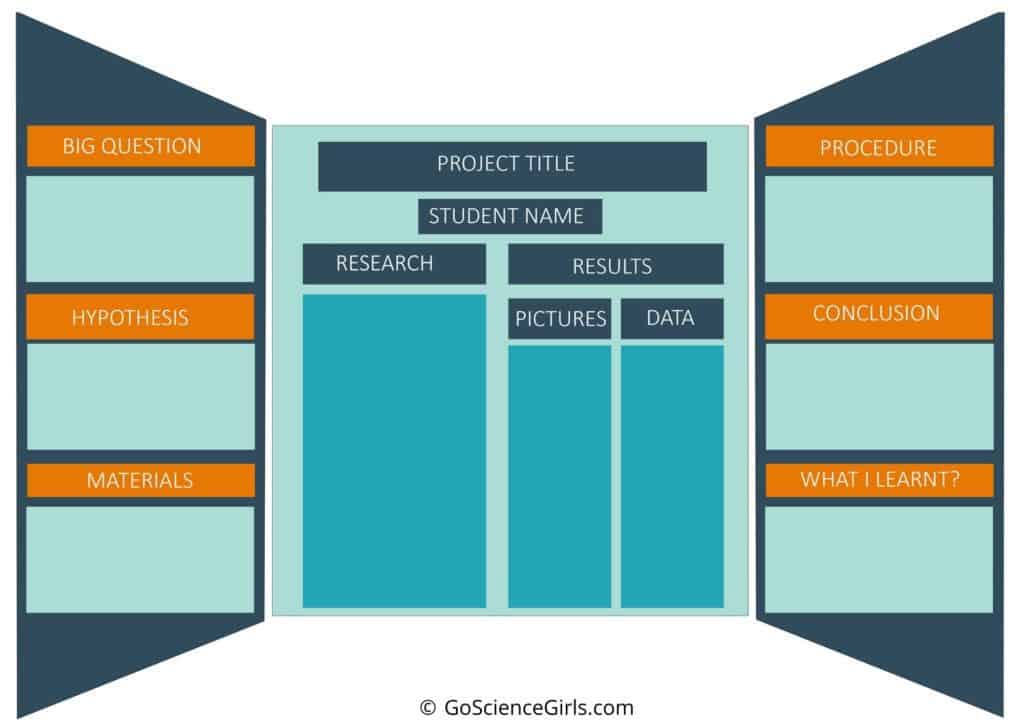
A science fair project display board is the first thing people look at when visiting your project room. Therefore, it is important to make a good impression.
You have to consider certain things while designing your project display board. For example,
* The background is very important. You can use any board or paper for the background, but keep in mind that the white colour needs to be bright.
* Use colour contrast. Use colours that are in contrast with each other. For example, you can use a black background with white-coloured text.
* Consider your theme. If your project is related to space, then consider using a space theme for your project display board.
* Use pictures. Pictures give your project display board a personalized touch.
* Include important information. Include information regarding the topic, as well as contact information.
* Use graphics. You can use graphs, diagrams, and figures to make your project display board look more interesting.
Size of Project Display Board
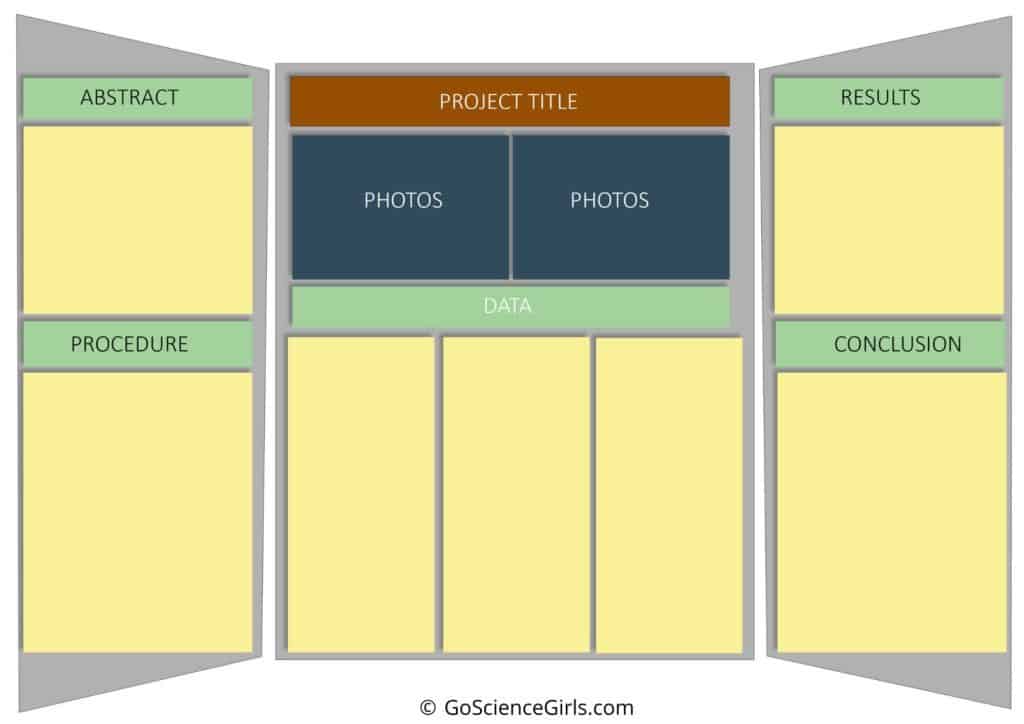
A science fair project display board is a large sheet of paper, poster board, or foam core used to display information about an experiment in a science fair.
The size of the board should
be at least 36″ x 48″.
The dimensions of the science fair board should be 2 feet wide by 3 feet long, and this allows for ample space to cover all the details and diagrams needed to present the research at an exhibition level.
Most science fair display boards have a 4′ by 10′ layout, which gives you plenty of room to cram all your data, photos, and drawings. But, if you want to pack in more information or a larger display board for a big project, there are alternatives.
One approach is to make the board out of the poster board. Posterboard comes in 2′ by 3′ sheets. You can arrange the sheets end to end to make a 12′ by 36′ display board. You don’t have to put these sheets together, though, and you can just join them at their corners and cut your display board to size.
You can also make a display board out of foam core. Foamcore comes in 2′ by 3′ sheets, too. You can buy it at most office supply stores. But, as with poster board, you don’t have to put these sheets together to make a display board. You can join them at the corners, cut your board to size, and glue the sheets together.
standard science project board size
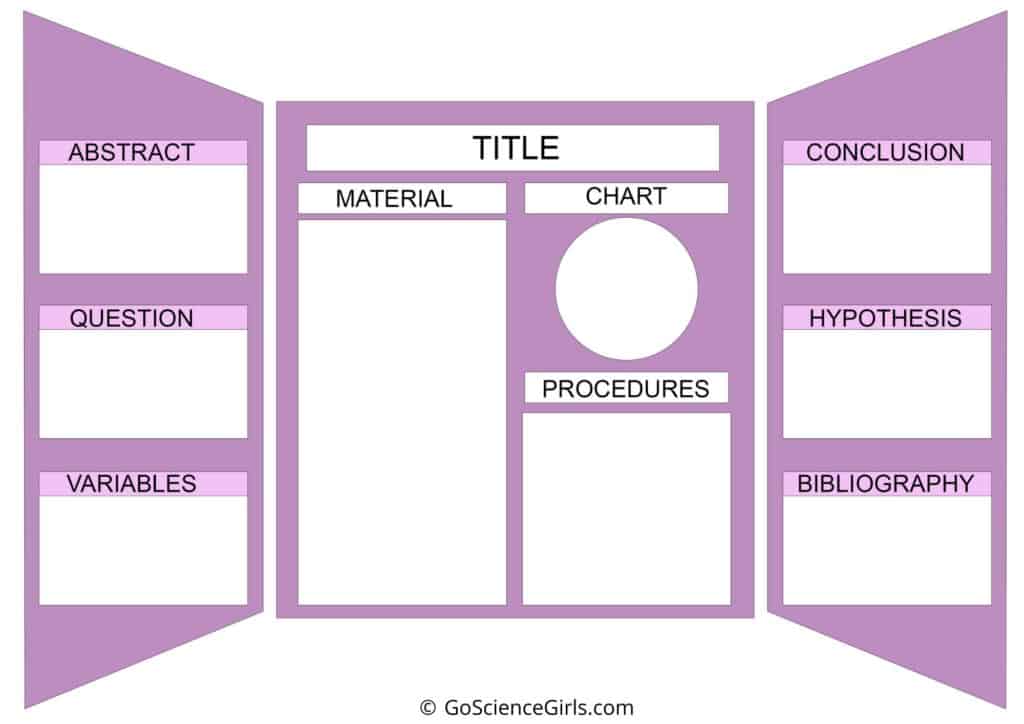
The standard scientific board size is arbitrary.
(It was originally called the Lincoln Board.) But it’s arbitrary in the same way that a dusty tube of paint is arbitrary. The colour you paint with isn’t important; what’s important is what you paint.
The rectangular board is better for making things. You can make almost anything rectangular, including mazes, making rectangular boards better for displaying science fair projects.
Once you’ve selected the perfect science display board, you have one final task: setting up the display.
How to set up a science project display board
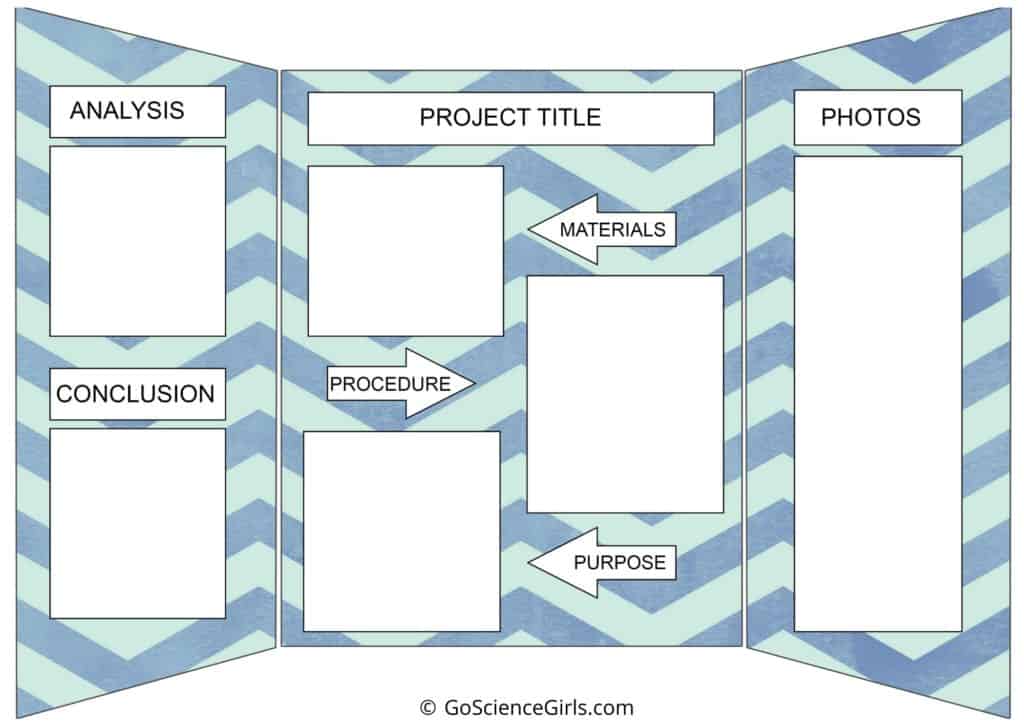
So you’ve found the perfect project, and you’re ready to construct your display board. Congratulations! Now, how do you get started? First, find blank poster board (or foam core) in sizes appropriate for your project. You’ll need at least a 24×36-inch poster board for your display board’s background (this is called a “background board”).
Then, find an image file or paper printout of your project. You’ll need to “posterize” this printout or image for use as your display board background. Posterize simply means shrinking or stretching it to fit within the boundaries of the poster board. The image below shows how you can do this:
Now, place the background board on a flat surface.
Center your printout or image on the board, and trim any excess.
Next, tape the printout or image to the board.
Then, tape the poster board to a flat surface (such as a table or countertop).
Finally, tape the decorative border (if applicable) to the board.
You now have your display board.
One simple rule to remember: Don’t crowd your display board.
Project display boards often serve a dual purpose. On the one hand, they provide a space for showcasing projects, but on the other, they serve as a gathering space for students and families.
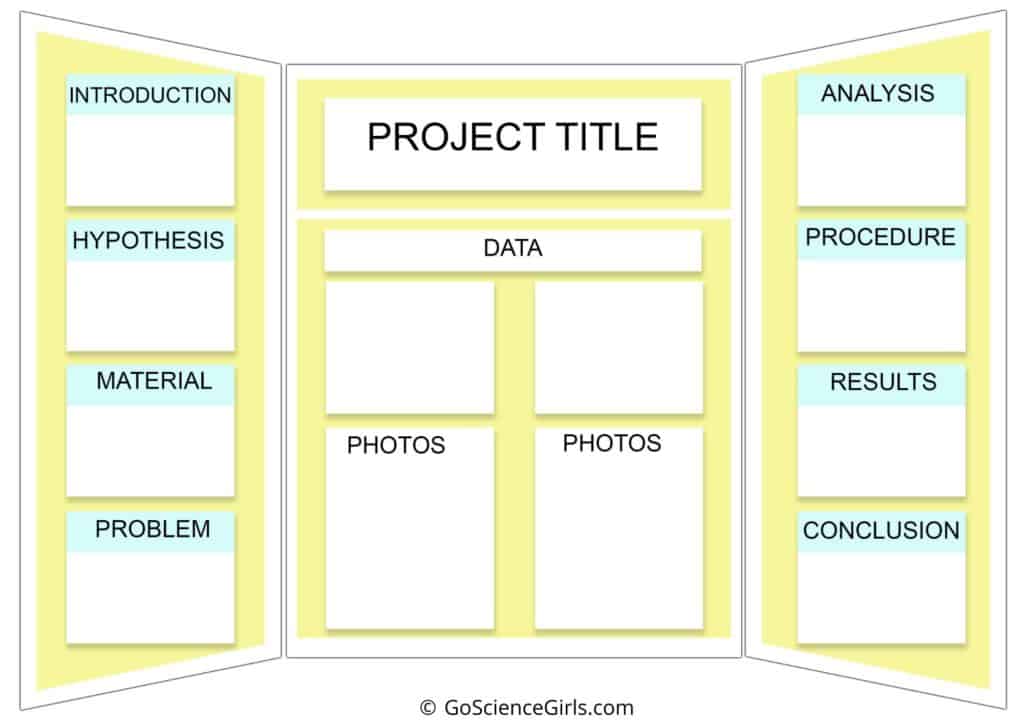
Here are some tips to make the most of your display board, whether you’re hosting or attending:
1) Placement is crucial. Make sure there’s room to move around the board and that it’s possible to read everything on it. Most boards should be 18 to 24 inches high and 36 to 48 inches wide.
2) Color counts. Colour helps differentiate projects. If you’re planning on hanging your display board, consider the colour contrast. Black text on dark backgrounds is easier to read than dark text on light backgrounds.
3) What goes on the board? Consider the length of your project. A 15-minute project should be photographed, but projects lasting more than 15 minutes should be described in the text. Test different layouts to make sure the board can be navigated easily.
4) How much detail? Photos should clearly show the project and explain how it works. Avoid “bullet points.” Students should be able to follow a project from start to finish without having to read anything.
5) Consider lighting. Try to place the board in an area that receives plenty of natural light. If your board is hung, make sure it has plenty of light behind it.
6) Writing. Consider using dry-erase markers. Writing on the board with a dry-erase marker is a quick and easy way to jot down notes, check off items on a to-do list, or display student responses.
7) Think about storage. You’ll want to store the board
Display Board Layout Types
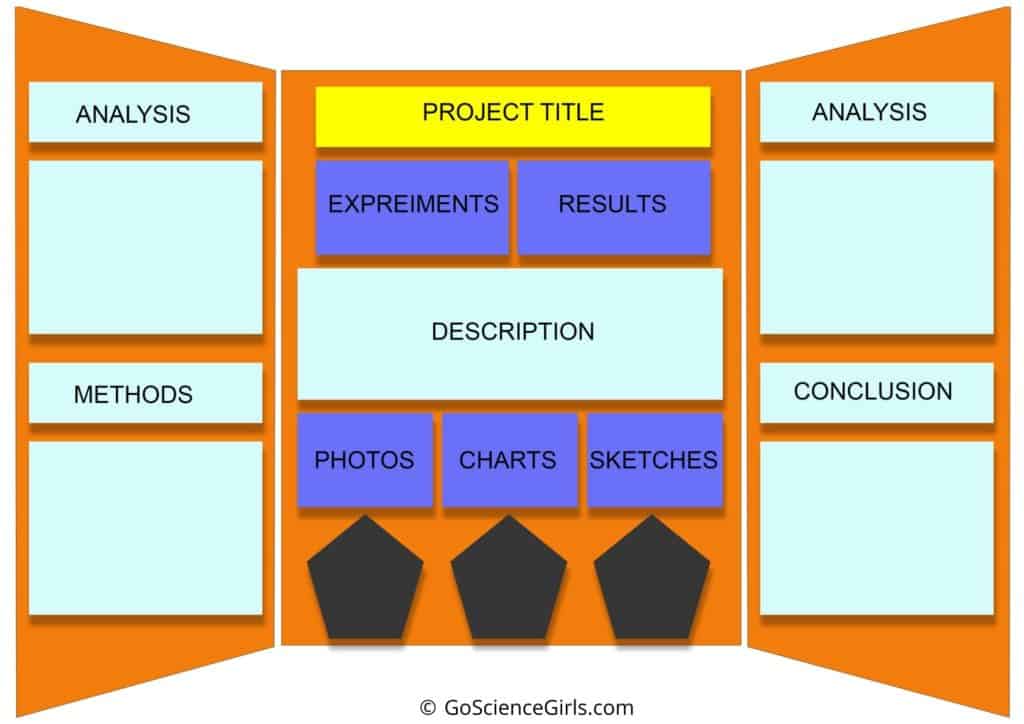
Display boards can be in different shapes, designs, and sizes, but a few standard layouts work well for science fair projects.
1. The “step and repeat” layout is the most common. This layout features one central background or image with many smaller images, text or graphics surrounding it.
2. The “block” layout is similar to the step and repeat, but it uses one large image, maybe with text or graphics, surrounded by smaller images or text.
3. The “grid” layout is similar to step and repeat, but it’s organized like an Excel spreadsheet, with columns and rows.
4. The “storyboard” layout features one large background or image with several smaller images, text or graphics around it.
5. The “poster” layout features one central background with a picture or text of project steps or process above it.
How to choose the best title for your science fair project
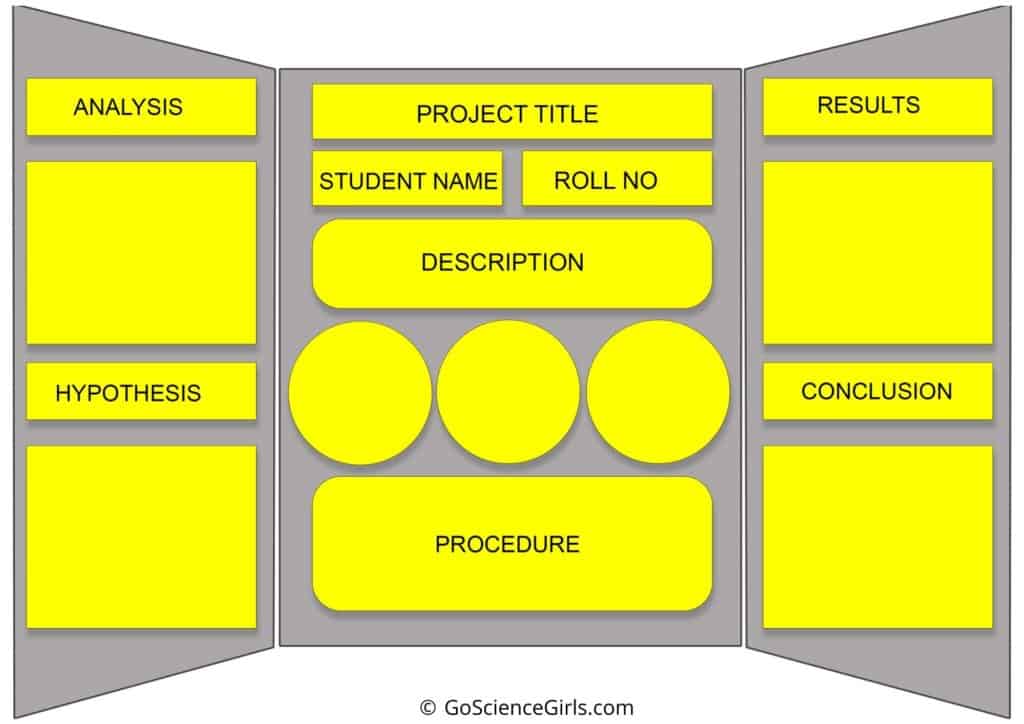
You spend hours or even days doing experiments, coming up with ideas, and collecting and documenting data. Many kids don’t realize that 80% of the hard work is done before you even start the project.
The first step in the process is to choose a good title for your project. This decision can make or break your project.
A creative, funny, or interesting title will catch the judges’ attention and may even make them laugh. On the other hand, a dull title may turn them off.
How you choose to title your science fair project says a lot about you. Your project’s title should be short but catchy. Your title should describe your project and highlight it.
So, how do you come up with a good title? There are several ways.
1. Ask an adult.
2. Look at the pictures on the magazine covers.
3. Make a list of your topics.
4. Do an Internet search.
5. Look for other interesting titles.
6. Think about funny titles.
7. Think about titles that will grab attention.
8. Think about descriptive titles.
9. Think about titles that express excitement.
Why Images / Visual Items are Important for Science Fair Display
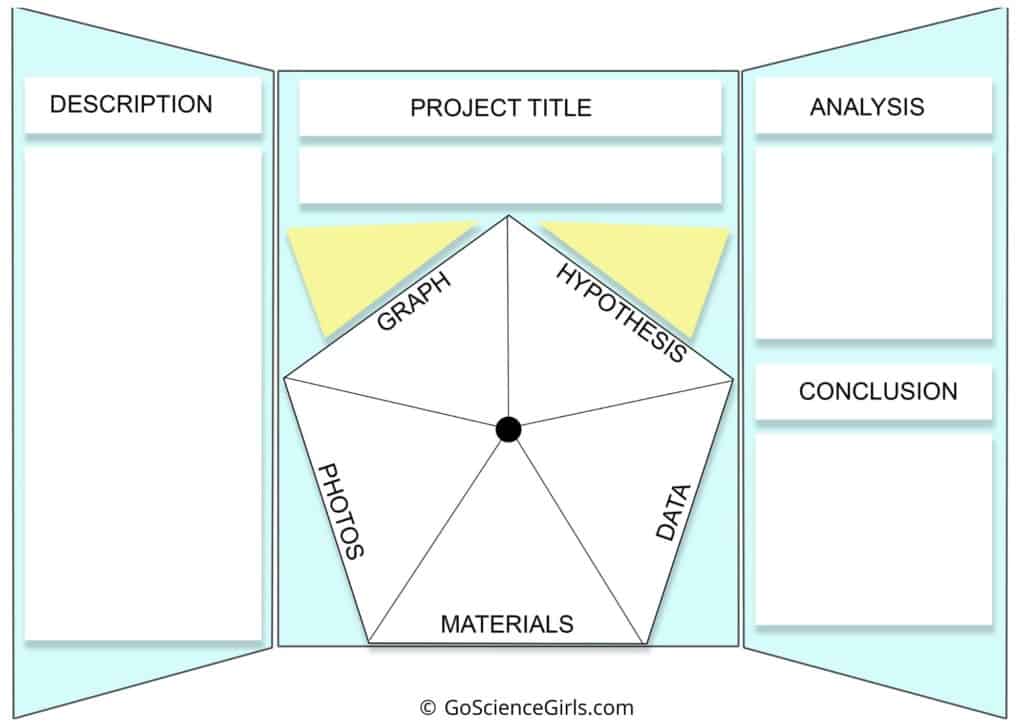
Visualizing your work is a great way to help other people understand it, so it’s important to make sure that your presentation is always clear. For example, if you’re making a poster, the first thing people will see is your title and subtitle, followed by your visual elements.
A science fair project display board presents several challenges. The first is making sure your text and graphics are the right sizes, so they don’t overwhelm your viewer.
The second challenge is making sure your text is easy to read. Many science fair display boards have a bold font. That can work if the font is easy to read, but in general, it’s better to go with a more subtle font that doesn’t compete with your visuals.
Your visual elements are just as important as the text. Images and charts need to complement your words, not overpower them.
The biggest mistake you can make is not including your visual elements. It’s important that other people understand what your project is, and images can definitely help with that.
For example, if your project tests the effect of a fertilizer on plant growth, pictures of different plants with different fertilizer levels would be important.
If your project is about the effects of pollution on fish, images of fish with different pollution levels would be important.
For a project about the effects of global warming, images of ice melting and icebergs breaking apart would be important.
Putting in a lot of effort to make your science fair project display board appealing and appealing is worthwhile. People will be interested in your project, and it will help make sure you achieve a good score.
Visual items, such as charts, graphs, photos, and displays, are unnecessary for every science fair project. Still, they do help to make the display more interesting and easier for the audience to understand.
It’s a good idea to have several different visual elements on your science fair project display board.
This lets the judges know you’ve thought carefully about the project and that you’ve done your homework.
Plus, having an array of visual elements allows the judges to compare and contrast your project with others.
Labels for Your Project Display Board
It seems like a lot of work to print out labels for all your charts and graphs for your science fair project display board. But, once it’s done, you’ll wonder why you didn’t label everything yourself.
First, you need to prepare the label sheets. Most printers come with label sheets, but you can get label sheets at any office supply store.
To make a label sheet, you just measure the height and width of the space you want to label and divide that by the label size. For instance, my label sheet measures 8.5″ by 11″. This means that I can print 8.5″ by 11″ labels.
Then, you print the labels on regular printer paper. To print labels, you simply select ‘Label’ from the printer menu.
When you’re finished, you just cut around the labels and punch a hole in them with your label puncher.
Here’s how to label all your graphs and charts:
1. Print the graph/chart onto the label sheet.
2. Cut around the graph/chart on the label sheet.
3. Punch a hole in the top left corner of the label.
4. Attach the labels to your graphs/charts with pushpins.
How to Setup Background for Your Project Display Board
A display board isn’t exactly a wall, so it doesn’t have to withstand as much weight or pressure. But if you stuff your board too full, people won’t be able to take in all the information you’re trying to convey.
Also, if your background is too busy, people won’t be able to read everything you’ve written.
On the other hand, if nothing stands out on your board, it might not even catch the eye of judges.
How to make informed decisions about background colours:
Use contrasting colours. Use colours that don’t match. Think complementary.
Use neutral colours. Use blacks, greys, whites and muted shades. These colours won’t distract the judges from what you have to show them.
Use bright colours. Use colours like yellows and oranges, but only very small amounts. Too much of it will stand out like a sore thumb.
Use colors that are neutral or bright. Use both dark and light versions of the same colours. This will balance your display.
Use dark colors. Use colors like grey, brown, or black. These colors aren’t as bright or distracting as bright ones.
Don’t use too many colours. Use no more than three colors for your background.
Stick to shades of the same colour for your background.
Background colours should be pleasing to the eye. Bright colours tend to grab attention, but dark colours can make your display look more mysterious. Select colors that blend well together for your specific project.
Why & How to Use Tri-fold display boards
A trifold project board is a formal way to present and display your science fair project. Often, the trifold display board consists of one large panel, which is divided into three smaller panels.
A tri-fold Science Fair display board often comes in single or double-sided versions, but the board can be any shape. Double-sided displays are more economical, but single-sided display boards provide more flexibility.
Your project display board needs to be large enough to hold the information you present but small enough to fit on a classroom board.
A display board that is 24 inches wide by 36 inches tall is a good starting point for most projects, but you may need a custom display board if your project is very large or complex.
You can assemble your display board very simply with foam core and poster board, but heavier materials usually require heavier frames. For heavier materials, the choice is usually between a tri-fold display board and a wall-mounted display board.
Tri-fold display boards are inexpensive, lightweight, and easy to transport, but they usually don’t offer much support for heavier materials. For thicker displays, you’ll probably need a sturdy metal frame.
The best way to display your project is by tri-folding the poster board.
The tri-fold display board is 11×17 and is 2.5 inches deep. A tri-fold display board can hold 2-3 science projects.
You should place all your project details on the tri-fold board.
You should write in your project title, date, and your grade level.
You can write in project details and results.
You should place your presentation in the center of the tri-fold board facing out.
You can include handouts, information sheets, and any associated materials.
You should add three small pictures in the center of the tri-fold board.
The pictures should be 5.5 x 7.5 and on plain white paper
Size of tri-fold science fair project display board
There are several options for the science fair display board, including tri-fold, tri-fold with portrait mount, and tri-fold with portrait mount and foam core board.
Tri-fold display boards come in various sizes, including 24 x 36 inches, 30 x 40 inches, 36 x 48 inches, and 36 x 60 inches.
The size of the science fair display board that you choose largely depends on the size of the science fair project.
If you display something small, such as a science fair project measuring 12 x 12 inches, then a 24 x 36-inch tri-fold display board may be a good choice.
However, if your science fair project measures 18 x 24 inches, you may need a 30 x 40-inch tri-fold display board.
Tips for choosing from Different Types of Display Boards
There are several types of display boards, each with strengths and weaknesses.
Variable display boards
Variable display boards are the simplest and most affordable. They can be as simple as a corkboard or a sheet of poster board, or they can be more elaborate, with pushpins, thumbtacks, and magnets to hold materials in place.
Variable display boards are useful for short, simple presentations. They can even be used to illustrate simple models, such as diagrams or Venn diagrams.
Oneway display boards
Oneway display boards are a variation on the variable board. Instead of providing multiple surfaces to attach materials, they typically have a single panel on which the materials are displayed.
Oneway display boards are more durable than their variable counterparts. For example, they’re made of heavier paper and can be mounted on the wall. They also tend to have more grommets or holes for hanging, making it easier to hang heavier materials. Oneway boards are often used for more durable materials like posters or blueprints. They’re also useful for presenting complex models, such as diagrams or Venn diagrams.
Pinnable display boards
Pinnable display boards are similar to one-way boards, but with one major difference: They can be pinned. Instead of being mounted to the wall, they’re designed to be pinned on walls. They’re useful for displaying posters and blueprints.
It’s simple: pick the one that’s right for you. Here are the differences among science fair display boards:
Display Boards: Also known as “poster board,” this type of display board will cover your entire wall. Display boards are rigid and don’t fold, so you’ll need a frame. They’re best for hanging, but you can also display them standing.
Poster Boards: Poster boards are thinner, more flexible, and fold smaller than display boards. They’re also easier to hang, but you may have to invest in a frame. They’re great for smaller projects.
Bulletin Boards: Bulletin boards are staples in classrooms, but they’re also useful for science fair projects. They’re sticky-backed and come in rolls. Bulletin boards can be hung on the wall, but they also work well on easels or tables.
Easels: Easels are a common part of classrooms, but they’re also useful in science fair projects. They’re ideal for displaying large projects, and they come in a few varieties, including folding, portrait and landscape.
Table Covers: Table covers are thin, vinyl sheets that can be attached to tables. They’re ideal for table-top displays because they’re easy to put up and remove.
Other Options: You can also hang your display board on the wall, using a frame or a poster frame, and you can display your display board on the floor.
Here are 10 tips for designing a good science fair display board
A science fair display board is the centrepiece of your science fair project. Your display board should clearly define your project and communicate its goals to the judge.
1. Show how you plan to carry out your project. A science fair display board should show how you will carry out your project. Include pictures, diagrams, and sketches along with the written description.
2. Include a budget. Include a budget for the whole project. The budget should include all of the costs, such as materials, labour, and any equipment.
3. Include a list of materials. Include a list of materials needed to carry out your project. Include brand names and retail prices if possible.
4. Use headings and subheadings. Use headings and subheadings to organize your project document.
5. Include a summary. Your summary should clearly describe the scientific problem you address, the steps you took to solve the problem, and what you learned.
6. Include the hypothesis. Explain the hypothesis, or idea, that you tested in your science fair project.
7. Explain the results. Explain the results you obtained.
8. Explain your interpretation. Explain how you interpret your results.
9. Include a bibliography with sources. Include a list of sources you used.
10. Leave room for corrections. Let the judge know if you made any changes or discovered new information during the project.
Here are 6 tips to make the most of your science fair project display board:
1. Pick an interesting display board. The display board is the centrepiece of your display. It should be eye-catching, and it should complement your project. It’s important to be creative here. Try to find something that fits your project theme. If you’re making a volcano, for example, a lava rock display board would be perfect.
2. Keep the display board simple. No rule says your display board has to be a work of art. Please keep it simple, or, at the very least, keep it clean.
3. Use complementary colours. Don’t overwhelm your display board with colours. Ideally, your display board will have a cohesive colour scheme. For example, if your project is volcanoes, your display board might have a warm colour palette.
4. Use contrasting colours. If your science fair display board has a central colour, use complementary colours as accents. For example, if your display board is red, use blue as an accent.
5. Use clear labels. It’s easy to get hung up with fine details, but the last thing you want to do is confuse your audience. Label everything on your display board.
6. Use contrasting fonts. Again, use easy-to-read fonts.
Tips for presenting in your science fair
Nothing is worse than being at the science fair and seeing someone else’s beautiful display. It leaves such a bad taste in your mouth and makes you think, “how could I be that poor?”
Well, I’m here to tell you that it is not as difficult as you think.
It’s especially important that everything you display is to scale. This means measuring your magnifiers and beakers first and marking their dimensions on your cardboard board.
Also, try to bring decorations that compliment your display. For instance, if your display is about solar energy, bring props from nature such as a tree branch or potted plants.
Time is also an issue. Don’t try to squeeze in last-minute projects. Give yourself plenty of time to finish, so you won’t be in a rush to get everything done.
“The first rule of presenting is: keep it simple,” says Jeffrey Palermo, Ph.D., chief scientist for undergraduate STEM education at the National Institutes of Health.
After you’ve spent countless hours tweaking your project, the last thing you want to do is fail to recognize its potential. Palermo recommends keeping the message simple: “If you don’t know what you’re talking about, then your audience won’t either.”
Here are some simple guidelines to keep in mind when you’re presenting your science project:
Keep it short.
A presentation should be no longer than 5 to 10 minutes. Short presentations also allow you to cover more ground, so your audience gets a stronger sense of what you’re presenting.
Keep it simple.
“Those 10 minutes are the most effective 10 minutes that students spend in their science classes,” Palermo says.
Keep it organized.
“A presentation should be a clear, logical flow from one step to the next,” Palermo says. Even if your science fair project is full of twists and turns, keep your audience on track by asking a few questions early and often.
Tell your audience what you’re going to present and why they should care. Sometimes that means repeating yourself.
Why & How to Use Digital Display Boards
For decades, display boards have been a mainstay in science classrooms, but in recent years, especially after the Corona impact, they’ve also become popular outside of schools.
This shift has occurred due to three factors.
First, technology has made it easier to create high-quality display boards, which has led to a sharp increase in demand for the technology.
Second, displays can be used for various purposes beyond school, including business presentations, trade shows, and museum exhibits.
Third, digital technology makes presentations more interactive and accessible to a wider audience.
As the demand for display boards has increased, so too have many companies offering digital versions of the boards. Digital display boards are the result of cutting-edge technology, but they’re also easy to use.
Here are some of the reasons why they’re ideal for science classrooms and other parts of an educational program:
• Easy scheduling, editing, and sharing. With digital board software, you can set up your displays in advance, then edit them or add additional content later. There’s no need for physical boards, which take up floor space, and they can be updated easily when new information becomes available.
• Versatile applications. Digital displays can be used for various purposes, from displaying information for students in the classroom to representing data for museum exhibits.
• Easy transportation. Digital displays can be transported easily, so they’re ideal for classrooms that have multiple classrooms. The displays can be set up and taken down quickly, and the software allows minor adjustments to be made on the fly.
• Cost-effective. Because digital displays are digital, they eliminate the costs associated with traditional boards, such as the cost of multiple printing runs.
• Eco-friendly. Digital displays have a smaller carbon footprint than traditional boards.
References
http://www.chicagostudentsciencefair.org/ – The best place to find information about the Chicago Public Schools Science Fair
http://www.neiu.edu/~sfc/ This webpage gives detailed information about the future CPS Science Fair dates in and around Chicago.
http://www.scifair.org/ How-to guides and tips on science projects created by teachers and former winners, all for your convenience
http://www.newton.dep.anl.gov/aasquesv.htm Argonne National Laboratory is one of the world’s foremost research centers for science, engineering, and technology. The website features over 10,000 questions and answers on various topics in science. The archive of questions has not only helped students find answers for their Science Fair projects but it also provides information to teachers who are looking for reliable sources.
http://www.acs.org/ American Chemical Society is an educational resource designed for the teaching of chemistry and chemistry related projects.
